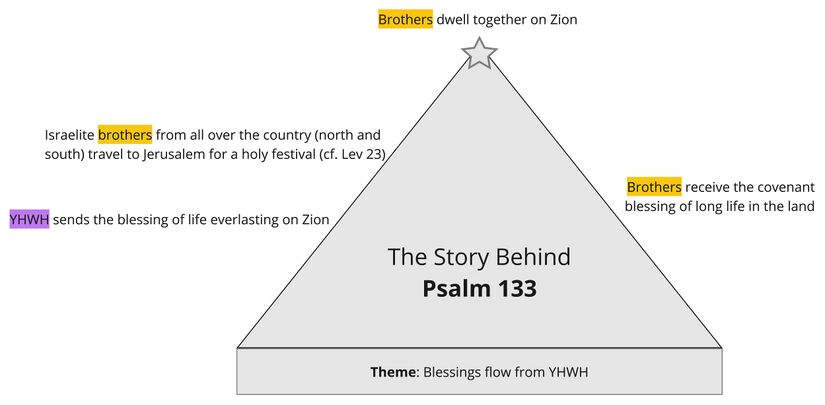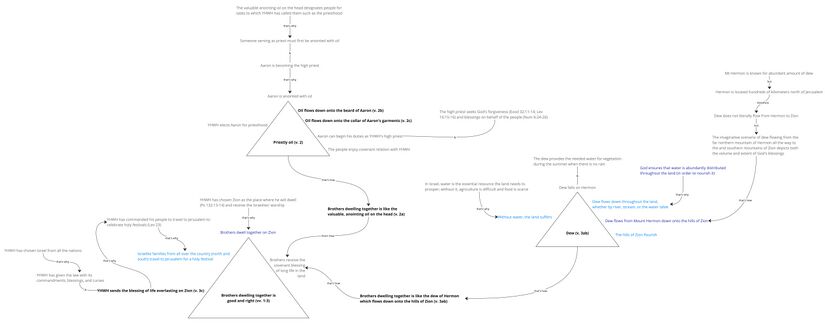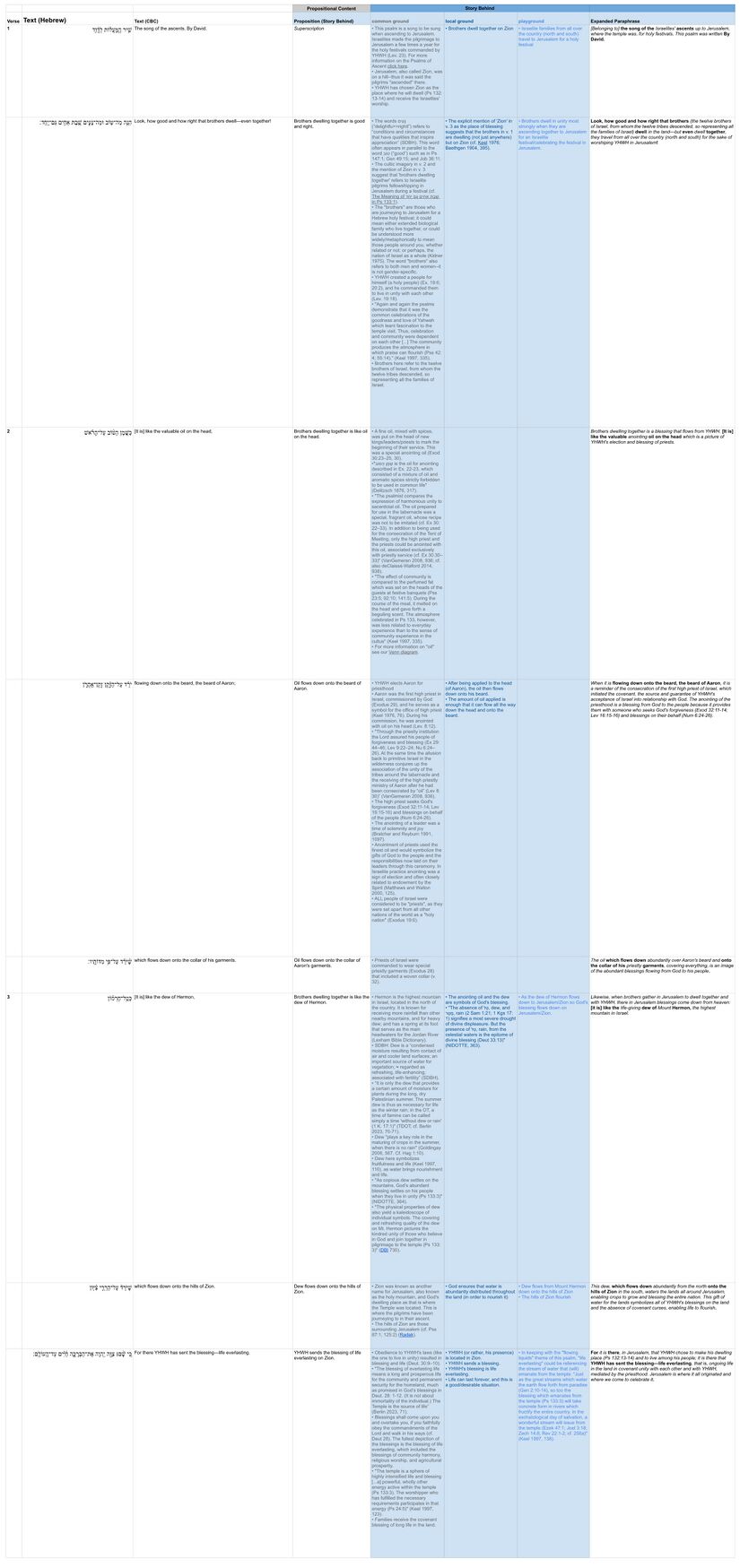Psalm 133 Story behind the Psalm
About the Story Behind Layer
The Story behind the Psalm shows how each part of the psalm fits together into a single coherent whole. Whereas most semantic analysis focuses on discrete parts of a text such as the meaning of a word or phrase, Story Behind the Psalm considers the meaning of larger units of discourse, including the entire psalm. (Click 'Expand' to the right for more information.)
The goal of this layer is to reconstruct and visualise a mental representation of the text as the earliest hearers/readers might have conceptualised it. We start by identifying the propositional content of each clause in the psalm, and then we identify relevant assumptions implied by each of the propositions. During this process, we also identify and analyse metaphorical language (“imagery”). Finally, we try to see how all of the propositions and assumptions fit together to form a coherent mental representation. The main tool we use for structuring the propositions and assumptions is a story triangle, which visualises the rise and fall of tension within a semantic unit. Although story triangles are traditionally used to analyse stories in the literary sense of the word, we use them at this layer to analyse “stories” in the cognitive sense of the word—i.e., a story as a sequence of propositions and assumptions that has tension.
Story Behind Visuals for Psalm 133
Summary Triangle
The story triangle below summarises the story of the whole psalm. We use the same colour scheme as in Participant Analysis. The star icon along the edge of the story-triangle indicates the point of the story in which the psalm itself (as a speech event) takes place. We also include a theme at the bottom of the story. The theme is the main message conveyed by the story-behind.

Background Ideas
- The valuable oil (שֶּׁמֶן הַטֹּוב) in Ps 133 is used to denote "the oil for anointing described in Exod 30:22-23, which consisted of a mixture of oil and aromatic spices strictly forbidden to be used in common life."[1] This oil was associated exclusively with priestly service[2]
- Zion, another name for Jerusalem, was where the Temple was located and was considered the meeting place between heaven and earth (cf. Pss 2:6; 78:68-69). It was also where the Israelites made the pilgrimage a few times a year for the holy festivals commanded by YHWH (Lev 23).
- Aaron was the first high priest in Israel, and he serves as a symbol for the office of high priest.[3] "Through the priestly institution the Lord assured his people of forgiveness and blessing (Exod 29:44–46; Lev 9:22–24; Num 6:24–26).”[4]
- When YHWH established his covenant with the people in the wilderness, this covenant involved blessings (≈ life) for covenant faithfulness and curses (≈ death) for covenant unfaithfulness (Deut 28-30).
- Mount Hermon was the highest mountain of the land of Israel, located in the far north, "known for its abundant dew,"[5] and thus an important water source for the arid land. Because Hermon is located hundreds of kilometers north of Jerusalem, the dew of Hermon flowing to the mountains of Zion is a geographical and meteorological impossibility. Rather, the figurative image of dew flowing from the far northern mountain of Hermon all the way to the arid southern mountains of Zion depicts both the volume and extent of God's blessings. His life-giving power, characterized by dew, covers and nourishes the entire land. Additionally, like the dew, brothers will gather in Zion from all over the country to worship God together, an event which is itself a blessing.
Background situation
The background situation is the series of events leading up to the time in which the psalm is spoken. These are taken from the story triangle – whatever lies to the left of the star icon.

Expanded paraphrase
The expanded paraphrase seeks to capture the implicit information within the text and make it explicit for readers today. It is based on the CBC translation and uses italic text to provide the most salient background information, presuppositions, entailments, and inferences.
(For more information, click "Expanded Paraphrase Legend" below.)
| Expanded paraphrase legend | |
|---|---|
| Close but Clear (CBC) translation | The CBC, our close but clear translation of the Hebrew, is represented in bold text. |
| Assumptions | Assumptions which provide background information, presuppositions, entailments, and inferences are represented in italics. |
v. 1
[Belonging to] the song of the Israelites ascents up to Jerusalem, where the temple was, for holy festivals. This psalm was written By David. Look, how good and how right that brothers (the twelve brothers of Israel, from whom the twelve tribes descended, so representing all the families of Israel) dwell in the land—but even dwell together, they travel from all over the country (north and south) for the sake of worshiping YHWH in Jerusalem!
v. 2
Brothers dwelling together is a blessing that flows from YHWH. [It is] like the valuable anointing oil on the head which is a picture of YHWH's election and blessing of priests. When it is flowing down onto the beard, the beard of Aaron, it is a reminder of the consecration of the first high priest of Israel, which initiated the covenant, the source and guarantee of YHWH's acceptance of Israel into relationship with God. The anointing of the priesthood is a blessing from God to the people because it provides them with someone who seeks God's forgiveness (Exod 32:11-14; Lev 16:15-16) and blessings on their behalf (Num 6:24-26). The oil which flows down abundantly over Aaron's beard and onto the collar of his priestly garments, covering everything, is an image of the abundant blessings flowing from God to his people.
v. 3
Likewise, when brothers gather in Jerusalem to dwell together and with YHWH, there in Jerusalem blessings come down from heaven: [it is] like the life-giving dew of Mount Hermon, the highest mountain in Israel. This dew, which flows down abundantly from the north onto the hills of Zion in the south, waters the lands all around Jerusalem, enabling crops to grow and blessing the entire nation. This gift of water for the lands symbolizes all of YHWH's blessings on the land and the absence of covenant curses, enabling life to flourish. For it is there, in Jerusalem, that YHWH chose to make his dwelling place (Ps 132:13-14) and to live among his people; it is there that YHWH has sent the blessing—life everlasting, that is, ongoing life in the land in covenant unity with each other and with YHWH, mediated by the priesthood. Jerusalem is where it all originated and where we come to celebrate it.
Story Triangles
Assumptions Table
Bibliography
- deClaissé-Walford, N., Jacobson, Rolf A., & Tanner, Beth LaNeel. 2014. The Book of Psalms (NICOT). Grand Rapids, MI: William B. Eerdmans Publishing Company.
- Delitzsch, Franz. 1877. Biblical Commentary on the Psalms: Vol. 3. Edinburgh: T&T Clark.
- Keel, Othmar. 1976. “Kultische Brüderheit.” Freiburger Zeitschrift für Philosophie und Theologie 23: 68–80.
- ________. 1997. The Symbolism of the Biblical World. Winona Lake, IN: Eisenbrauns.
- VanGemeren, Willem, A. 2008. "Psalms," in Tremper Longman III and David E. Garland (eds.) The Expositor’s Bible Commentary: Psalms (Revised Edition). Vol. 5. Grand Rapids, MI: Zondervan.
- Walton, John H. 2009. The Minor Prophets, Job, Psalms, Proverbs, Ecclesiastes, Song of Songs. Zondervan Illustrated Bible Backgrounds Commentary: Old Testament. Vol. 5. Grand Rapids: Zondervan.

